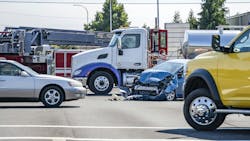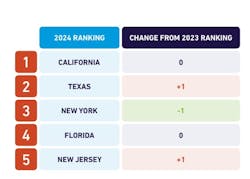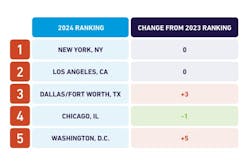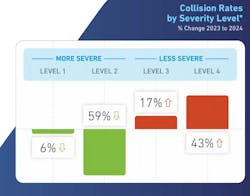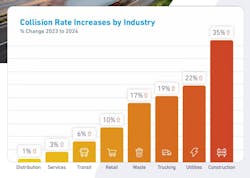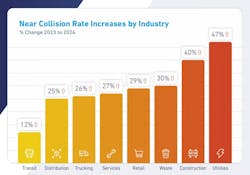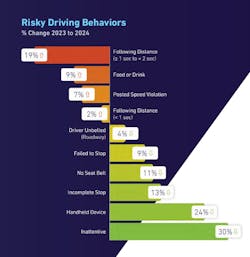Collisions up 24% due to more road congestion, risky driving, Lytx report finds
In its 2025 Road Safety Report, Lytx found since 2023, collision rates and risky driver behaviors have been on the rise across the world. The telematics and safety technology provider found that collision rates climbed by 24% since Q4 2023, though were less severe in nature. Vehicles that kept a following distance of less than 1 second rose by 18%, while speed violations rose by 9%. The report noted that as roadways have become more congested, “close calls” and near collisions were up 52% in Q4 2024 versus Q4 2023.
To collect this data, Lytx examined data from over 300 billion miles of driving from 5.5 million drivers across 90+ counties, including over 209 million new driving events and 106 million driving behaviors from DriveCam event recorders.
Where and when drivers should be on high alert
Lytx identified that risky behaviors such as following too close, phone usage, speeding, and inattentiveness were most prevalent in the following states:
- California
- Texas
- New York
- Florida
- New Jersey
The specific riskiest cities in order were:
- New York City
- Los Angeles
- Dallas/Fort Worth
- Chicago
- Washington, D.C.
Lytx said Tuesdays were the riskiest day to drive and Sunday the least. In general, between 1 p.m. and 3 p.m. were the times when risky driving was highest in 2024, peaking at 2 p.m. Collisions were up 12% on major U.S. holidays versus comparable "regular" days the rest of the year.
“The Lytx 2025 Road Safety Report is a powerful reminder that as our roads continue to see increased volumes of traffic, the nature of risk is evolving,” said Peter Goldwasser, executive director at Together for Safer Roads. “What this data makes clear is that better understanding and proactive management of these new patterns of risk is critical. At Together for Safer Roads, we believe insights like these are key to shaping smarter, more responsive safety strategies for fleets, cities, and policymakers alike.”
Collision data
For collisions, the company found that increased road congestion and traffic volumes resulted in overall higher collision rates. More specifically, the amount of lower-severity crashes increased, but higher-severity crashes dropped. For instance, the number of low-severity crashes rose by 43%, while minor accidents rose by 17%. Moderate crashes dropped by 59% overall.
In the report, this could be due to how roads are more crowded (according to INRIX 2024 Global Traffic Score Card) and how average speeds across major road arteries dropped (according to the U.S. Bureau of Transportation Statistics, Supply Chain and Freight Indicators, May 27, 2025).
On a granular scale, while all industries saw their crash rate rise, construction and utilities companies tended to bear the brunt of the issue. In 2023, construction’s collision rate rose 35%, and utilities’ went up by 22%. However, trucking was the third highest industry to get into accidents, with its collision rate rising 19% from 2023 to 2024, and Waste went up by 17%.
“Our crash data shows a rising number of incidents where professional drivers are struck by others, often while our drivers are doing everything right,” said Jeff McKinney, VP of safety at Jetco, in the report. “Being in the right isn’t always enough. It’s about showing up with your A game, every time.”
The rate of near collisions climbed as well throughout 2024. Near collisions jumped by 52%, with every industry again seeing an increase. Construction and utilities again saw the most near-collisions, with utilities’ near-collision rate rising by 47% and construction jumping by 40%. Waste’s near-collision rate went up by 30%, while trucking’s went up by 26%. However, the increase in near collisions isn’t necessarily bad.
“It may seem counterintuitive, but near collisions can be a good sign,” said Kyle Warlick, sr. data analyst for Lytx in the report. “In many of these cases, drivers took action to avoid collisions, building proper following distance, or positioning their vehicles in ways that give them space to maneuver.”
Factors driving collisions
While there are many factors that can drive accidents, driver behavior, weather, and location can have a big impact. For driver behavior, Lytx found that tailgating and speeding, especially in bad weather, were among the top driver risks in 2024. Additionally, driver following distance worsened as well, potentially due to increased traffic.
Specifically, the rate of drivers maintaining a following distance of 1-2 seconds rose by 18%, while those eating and drinking while driving rose by 9%. But on the positive side, the rate of inattentive drivers fell by 30%, and handheld device usage dropped by a quarter.
However, bad weather tended to increase driving risks, with foggy conditions resulting in drivers being 2.8x more likely to be in a high-severity crash.
Increasing road safety for drivers
However, Lytx’s report also found several ways to increase driver safety while on the road, including timely and effective coaching and using new technology such as dash cams.
For instance, some of the top behaviors coached in 2024 were stopping at red lights and stop signs (55% of coaching sessions in 2024). But for every 100 coaching sessions, 73 resulted in the behavior not recurring over the next two months. This is especially when done within 6.7 days after the incident, which Lytx reported had an over 80% efficiency rating.
On the technology side, Lytx reported that their clients showed an 8.7% reduction in speeding and a 2.8% increase in trips per vehicle in 2024. Additionally, fleets that used Lytx devices to guide their coaching achieved $22 million in fuel savings (based on the 2024 average fuel cost of $3.76 per gallon of diesel) and 100 million lbs. of CO2 emission prevented. The company also estimated that their DriveCam and GPS Fleet Tracking and Preventative Maintenance helped save clients $521 million on vehicle maintenance and $1.8 billion on claims costs.
About the Author

Alex Keenan
Alex Keenan is an Associate Editor for Fleet Maintenance magazine. She has written on a variety of topics for the past several years and recently joined the transportation industry, reviewing content covering technician challenges and breaking industry news. She holds a bachelor's degree in English from Colorado State University in Fort Collins, Colorado.
